Have you recently purchased an e-bike, or do you plan to buy one? If the answer is yes, then you really need to know how to charge an electric bike.
Electric bikes are becoming increasingly popular as an alternative mode of transportation. They come with many advantages over traditional bicycles.
E-bikes require less effort to pedal, can get you up hills faster, and even help reduce your carbon footprint. However, electric bikes are expensive than traditional bicycles, and their most expensive component is their battery.
You will need to regularly charge your e-bike’s battery, and you should know how to take care of it.
In this blog post, we will explain everything you need to know about how to charge an electric bike safely and effectively.
- Also Read: Test Ride an E-Bike
- Also Read: E-Bikes for Beach Sand
- Also Read: E-Bikes for Uber Eats
How to Charge an Electric Bike Battery at Home?
The process of charging your electric bike battery at home is quite easy. The battery is like the heart of an e-bike because it pumps the power to different components. A sufficient and functioning battery means regular bike riding for you.
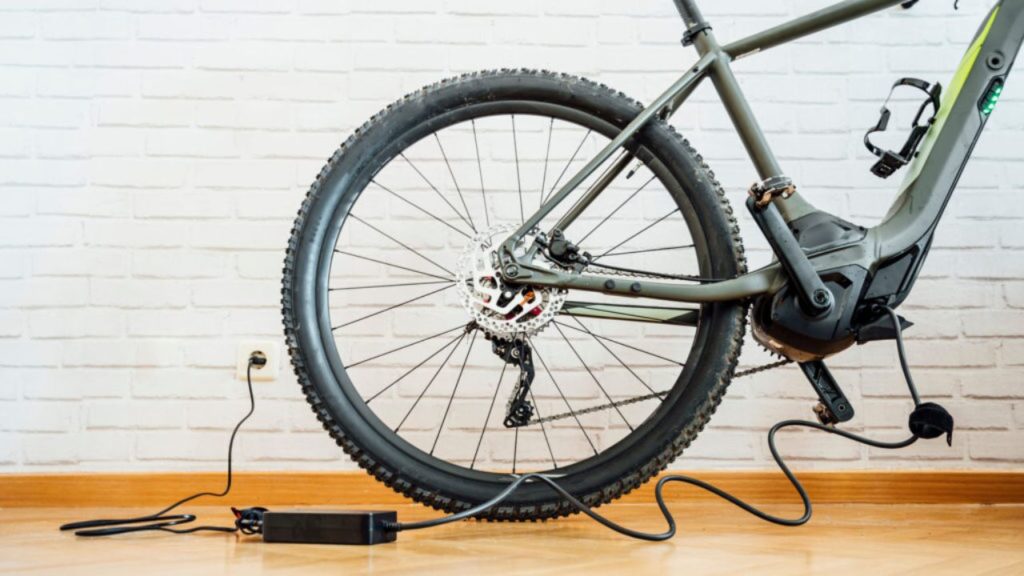
There are a few things that you need to charge your e-bike battery at home. The first thing is the access to an electrical outlet. Second, you will need a charging cable that is compatible with your bike.
If your electric bike has a removable battery, then you will need to remove it from the bike before beginning the charging process. Most e-bikes nowadays have removable batteries.
Simply plug the charging cable into the electrical outlet and then into the charging port on your bike. If your battery is removable, insert it into the charger before connecting the charger to the power source.
Once everything is properly connected, the charging process will begin automatically. Charging times can vary depending on the size of your battery and the type of charger being used, but most batteries will be fully charged within 4-6 hours.
Steps To Charge an Electric Battery at Home
The steps to charge an electric bike battery at home are very much the same as charging any other battery-powered device.
You can follow these 7 steps to charge your e-bike at home:
- Position your electric bike near the electrical outlet if the battery is irremovable.
- If the battery is removable, then you can remove the battery and bring it close to the electrical outlet.
- Remove the battery cap and unscrew the charging port cover.
- Connect the charger to the battery.
- Plug in the charger to the outlet.
- Monitor the charging process and unplug when complete.
- Replace the charging port cover and screw it back on.
- Reattach the battery cap.
The Duration of Charging Electric Bike Battery at Home
The duration of charging an electric bike battery at home varies from 3 hours to 8 hours. The variation in time depends on a few factors, such as type and size of battery, charging cable, quality of battery, and power supply voltage.

The first factor is the type of battery. If your e-bike has a lithium-ion battery, then it will take 3 to 6 hours to fully charge. However, a lead-acid battery of the same capacity may take up to 10 hours to fully charge.
Lithium-ion batteries take less time to fully charge because of their ability to accept an electric charge at a faster rate.
A bigger battery will take more time to fully charge as compared to a small battery. A new battery takes less time to charge than an old battery.
The charging cable also affects the duration of charging. The cable that your e-bike’s manufacturer provided you supply the right amount of charge. It takes more time to charge your battery, but it prevents your battery from getting damaged.
You can purchase a fast-charging cable that is not recommended by the manufacturer. It may supply more charge to the battery and reduce the charging time. However, it can badly damage your battery.
The voltage of power supply is another factor that can affect the charging duration of your battery. A power supply with high voltage will charge the battery at a faster rate than a power supply with low voltage.
In the US, the power supply voltage is 110 volts. However, the power supply voltage limit in Asian and European countries is 240 volts. Therefore, the charging duration of your e-bike battery will depend on your region too.
How to Know Your Electric Bike Battery is Fully Charged?
Electric bike batteries have inbuilt LED lights that show the level of their charging. If the LED light of your e-bike turns red, it means that your battery is fully discharged, and you should charge it now.
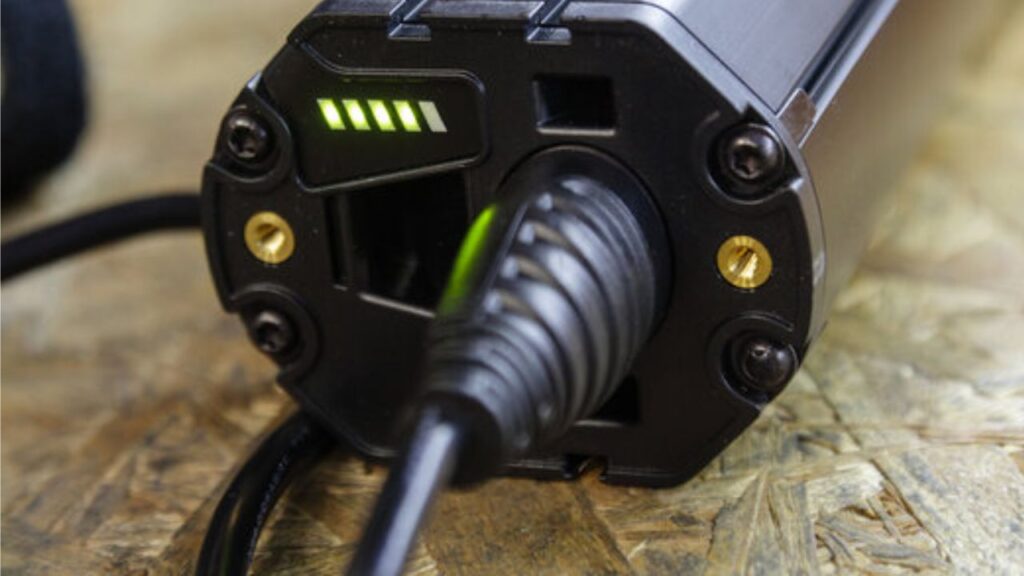
When you plug your e-bike battery into an electricity outlet, the LED lights turn orange or yellow. It will keep blinking during the charging process. This blinking of yellow or orange LED lights is an indication of successful charging.
After a few hours, the LED lights of your electric bike battery will turn green. This means your battery has charged to a certain level, and you can now remove the battery from charging. Removing the battery at this point will prevent it from getting overcharged.
Red LED light means your battery percentage is between 0 to 20%. Yellow or orange LED light means the battery percentage is between 20 to 85%. And green LED light means the battery percentage is between 85 to 100%.
Keep in mind that there are no LED lights in unremovable e-bike batteries. Such electric bikes have inbuilt LCD meters that will show you the level of battery charging.
The location of LCD meters is usually on the handlebars or the middle of the e-bike. The display shows you information like battery range, charging level, and temperature of the battery.
Can You Charge Your Electric Bike With Solar Energy?
You can use solar energy to charge any electrical device that runs on a battery, including electric bikes. The size and capacity of your e-bike battery will determine charging duration, number of panels, and the amount of sunlight.
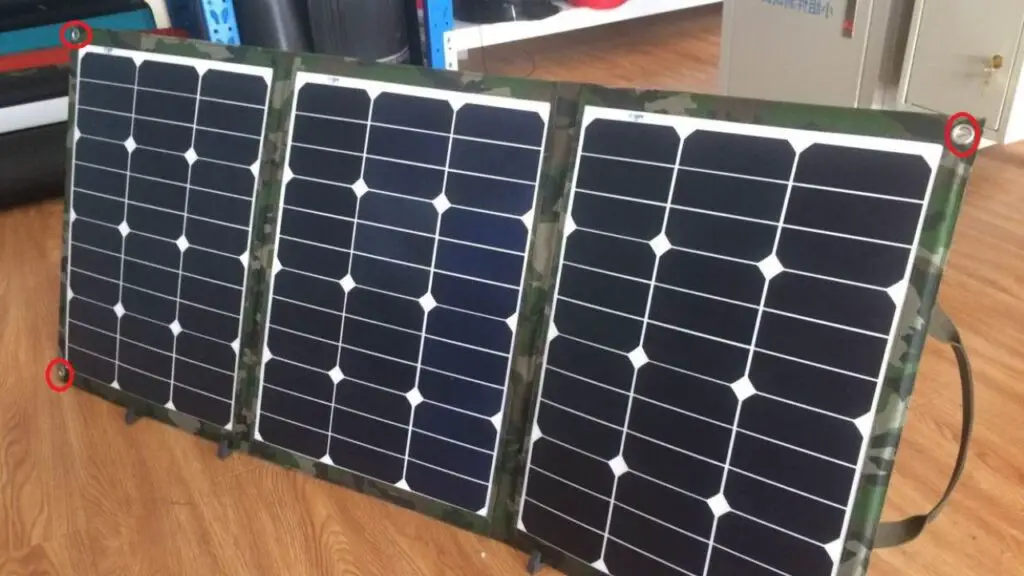
You need to follow the below steps to charge your e-bike battery with solar energy:
- You need an inverter and a solar panel of 100 to 200 watts. Inverters are usually available at the solar panel shops.
- Now connect the inverter and solar charge controller to your e-bike’s battery.
- Connect the solar charge controller to the solar panels.
- The LED light of your battery or the display screen of your electric bike will show if the charging has begun.
How to Charge an Electric Bike When You Are Not at Home?
The primary purpose of electric bikes is to provide you with convenient and comfortable commute. It is why you can still charge your e-bike battery when you are not at home.
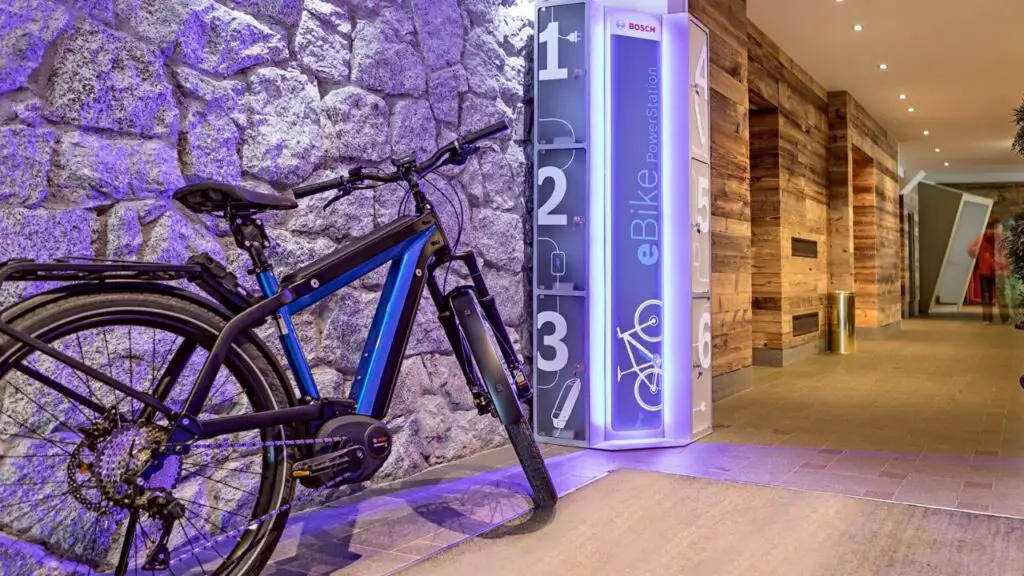
There are a few things you can do to charge your electric bike battery when you are outside your home.
Take your charging cable with you when you go out. You can easily fold the charging cable into your bag because they are lightweight and foldable.
This will enable you to charge your electric bike battery anywhere. You just need to find an electric outlet and connect it to your battery.
Another thing you can do is to keep an extra charging cable at your college locker or your office. This will enable you to charge your e-bike battery without bringing a charging cable from home.
You can charge your e-bike battery at an electric bike shop. You can also charge your e-bike battery at an electric car supercharging station. However, you must use the right charging cable; otherwise, it can damage your battery in no time.
If you are transporting your electric bike in your car, then you don’t need to find a charging source. You can directly charge your e-bike from your car. Keep in mind that repeatedly charging your e-bike can discharge your car’s battery.
You can carry an extra e-bike battery if you are traveling to a place where there is no e-bike store or power outlet. This will enable you to stay on the road without worrying about your e-bike battery dying out.
Safety Precautions and Considerations for Charging Your Electric Bike
When charging your electric bike, there are a few safety precautions and considerations to keep in mind. Doing so will prolong your e-bike’s battery life.
The very first thing you should do is to thoroughly read the instructions manual that came with your electric bike. This would help you understand important things about your e-bike’s battery.
You must know the size and type of your e-bike battery. You should also know the preferred voltage, charging time, and any limits for your battery. Never charge your e-bike battery without reading the instructions manual to prevent any damage.
You should only use the electric charger provided by the manufacturer and avoid using any other charger. The manufacturer-provided charger supplies the right amount of electric charge to your battery. It will protect your battery’s lifespan and range.
If you use a fast charging cable to charge your e-bike battery, it may reduce the charging duration, but it will severely damage the battery.
You should always switch off the power supply when connecting and disconnecting the battery charger. It will protect you from getting electrocuted from a power surge.
You must never leave your electric bike unattended for a prolonged time during the charging process. A lithium-ion battery can explode with a fire, so keep it away from all types of flammable objects.
Never charge your electric bike battery if it is damaged. Keep in mind that exposed battery cells or leaked battery fuel can catch fire, and the battery will explode.
It is best to let a professional check your e-bike battery if it falls. It may seem fine, but it may be damaged.
How To Make Your Electric Bike Battery Last Longer?
The battery of your electric bike is the most sensitive and expensive component. It can die earlier and discharge quickly if you misuse and neglect it.
You can prolong the total life of your battery and improve its range per charge if you properly take care of it. You can do the following things to make your e-bike battery last longer:
- You should always ride your electric bike when it is fully charged. This will allow your bike to travel at higher speeds and improve your battery’s range.
- Charge your electric bike battery to the 100% when you purchase it. It will take up to 13 hours to fully charge the first time. This will allow the electric charge to run through your new battery and activate all cells.
- The battery’s capacity and total range drops when you recharge it after a complete discharge. Therefore, you should never completely discharge your e-bike battery.
- Keep in mind that your battery’s lifespan will shorten, and it will get discharged quickly as it gets old.
- Experts say that you should charge your lithium-ion batteries between 21% to 88% charging. They say your battery’s charge storing ability and range will reduce if you charge your battery below or above this range.
- You should never overcharge your electric bike. Leaving your e-bike battery to charge for over 20 hours can reduce its capacity and damage its cells.
- You should always charge your e-bike battery at least 20% before storing it. If you store a fully discharged battery, it will lose its ability to store charge.
- It is best to charge your e-bike battery as frequently as you can.
- You should always use the charger that comes with the e-bike. Also, follow the manufacturer’s instructions. Contact the manufacturer if there is a confusion. It will help you prevent doing any damage to your e-bike’s battery.
- Make sure the electrical outlets you use for charging have a stable power supply. Your battery can get severely damaged if it is exposed to high electricity.
- You should avoid riding your e-bike in very hot or very cold weather conditions. It can reduce lifespan and performance of your battery. A lithium-ion battery can explode if it is overheated.
- You should also install fenders on your electric bike to protect the battery from debris, mud, and sun.
Factors Impacting Electric Bike Battery Range
The range of your electric bike battery depends on different factors. The first thing you must know is the model and manufacturer of your e-bike. You must also know the average range of your e-electric bike.

Some electric bikes have light indicators that show how much further you can travel on your e-bike. High-end electric bikes have an LCD display that shows you the percentage of your battery. It gives you an idea that how further you can ride your bike.
The factors that can impact the range of your electric bike include your riding style, overall riding conditions, and the weight you are transporting.
Your Riding Style
Your riding style is the most important factor that impacts the range of your e-bike. It means how much assistance you take from the battery, and how much you pedal the bike while you ride it.
The speed at which you ride your e-bike will also impact the range. The battery will discharge at a much faster rate if you ride the bike at maximum speed.
The number of stops and starts also drains your battery. You lose the momentum when you stop your e-bike. The bike then consumes more battery power to gain the speed, especially on an uphill ride.
The amount of battery power you consume during your daily ride will help you know how long your battery can last. All other factors have a minor impact on the range, even the battery age and tire pressure.
Overall Riding Conditions
Certain weather conditions impact your e-bike’s battery range. Your battery will die out much faster if you are riding in extremely cold or extremely hot conditions. However, a battery lasts longer in warmer conditions than a colder conditions.
Your electric bike will need to work harder to propel you if you are riding up a hill or in headwinds. If you ride your e-bike in hilly areas, then you will need to charge it more often.
The terrain also affects the battery range of your electric bike. If you ride your e-bike on bumpy terrains or on softer surfaces, then the battery will need to do more work.
A good way to understand why the terrain affects the battery range is to experience how hard it will be for you to ride an ordinary bike on a bumpy terrain. The same way your battery will need to work harder to propel the bike on such a terrain.
Weight You are Transporting
The weight that your electric bike is moving will greatly impact on the range of your battery. This includes your weight, bike weight, and anything you are carrying. It will also include a trailer or small wagon for children.
The battery will have to work harder if it is moving more weight. Your e-bike battery will drain faster if it is transporting heavier weights.
Things Not to Do With an E-Bike Battery
If you have an electric bike, there are a few things you should avoid doing with the battery. Here is a list of things not to do with an e-bike battery:
- Never cover the battery while you are charging it
- You should not charge the battery if the temperature is below freezing or above 110 degrees Fahrenheit
- Never use a charger other than the one your manufacturer provided
- Never try to dismantle the battery
- Never crush the battery
- Always keep the children away from the battery
- Never try to short circuit the connections of the battery
- Never leave the charger permanently connected to the power outlet
- Never leave the battery unattended while it is charging
- Never go to sleep while the battery is charging
- Never immerse the battery in a liquid
It is normal for the charger to get hot while the battery is charging. However, if it is very hot, or it smells strange, then it is overheating. In that case, you should immediately switch off the power outlet.
Never charge your battery if the charger is overheating. You should also contact the manufacturer for further guidance.
Conclusion
It is a simple and straightforward process to charge an electric bike. You can do it with a few basic steps. The first step is to locate the charging port on the bike and ensure that it is free from dirt or debris.
The next step is to connect the charger to a power source and insert the other end of the charger into the charging port on the e-bike.
It is essential to use a charger that is specifically designed for your electric bike model. Using the wrong charger can damage the battery and even pose a safety risk.
It is best to charge your electric bike after each ride, especially if you have used it extensively. This will ensure that the battery remains healthy and fully charged.
To optimize the battery’s lifespan, avoid overcharging or undercharging it. You should disconnect the charger once the battery is fully charged. Avoid charging it overnight or for extended periods.
You should ensure the battery is properly cooled during the charging process. Overheating can damage the battery and reduce its lifespan and range.
By following the above mentioned guidelines, you can keep your electric bike’s battery healthy, prolong its lifespan, and enjoy a hassle-free riding experience.
Frequently Asked Questions
How far can an electric bike go on a charge?
Most electric bikes can travel up to 45 miles on a single charge. High-end electric bikes can even go up to 70 miles on single charge. It mainly depends on the battery power, but it also depends on the terrain and how much the rider pedals.
How much does it cost to charge an electric bike?
The cost of charging an electric bike depends on the electricity rates in your country. However, the cost is usually less than a cent per mile. You can check out this article for details.
How do I maximize the life of my electric bike’s battery?
You can maximize the lifespan of your electric bike battery by not overcharging or undercharging it. Always use the manufacturer-provided charger. Do not store it fully discharged and protect it from extreme weather conditions, especially heat.
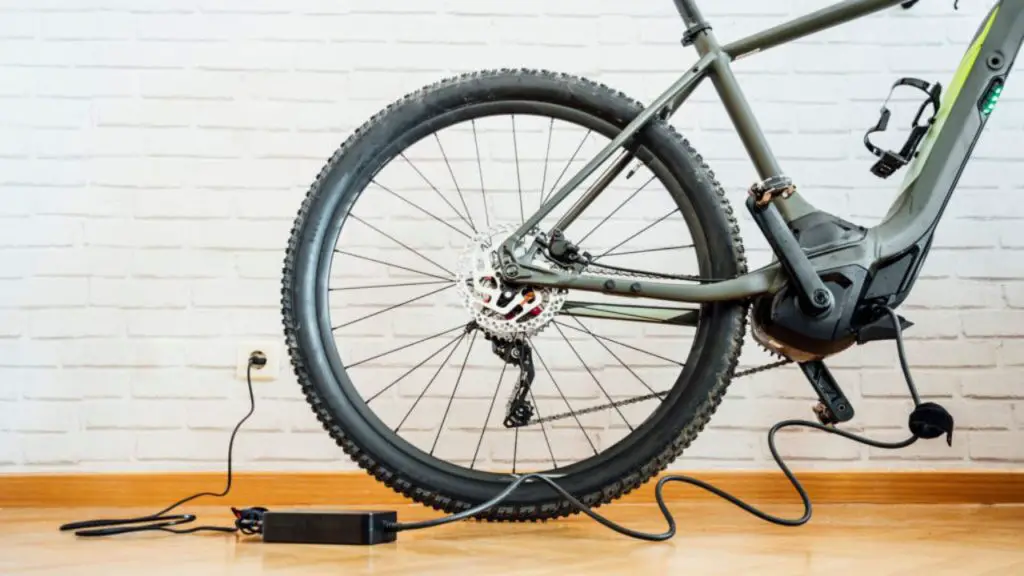
Pingback: 10 Best Suspension Seatposts for Electric Bike in 2023
Pingback: How Long Does an Electric Bike Battery Last | Battery Life
Pingback: A Buyer’s Guide to Electric Bike for Uber Eats